May = Plants-In-The-Ground
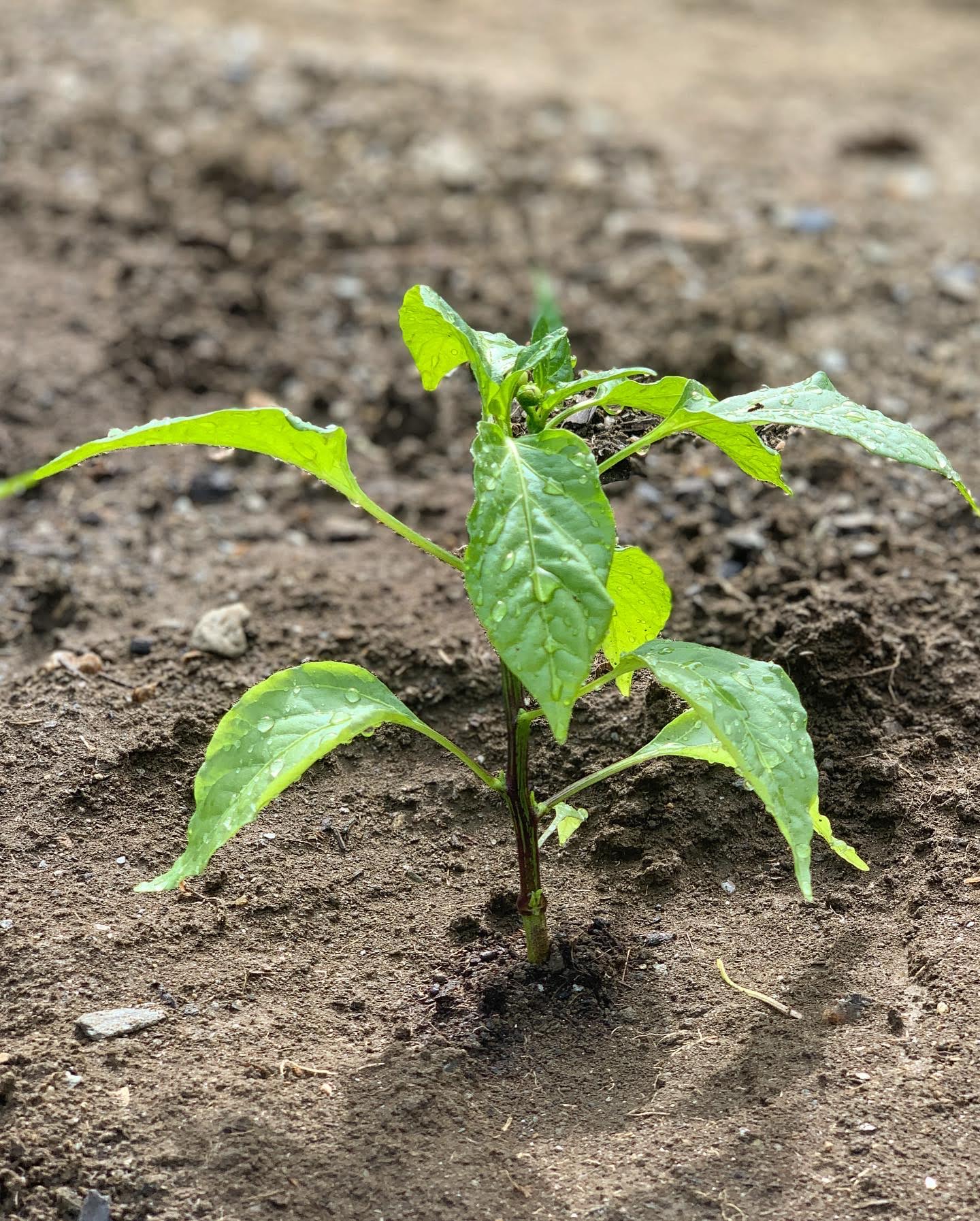
The vegetables we started from seed back in February were booted from the warmth of the kitchen into the wilds of the garden. For weeks, we took our plant starts outside for field trips to feel the breeze and learn about the sun.
Finally, in mid-May, we nestled each nascent veggie into hand-dug reservoirs of fine dirt (except for the ones the kids planted, which were jammed into the soil with negligent supervision and for that, I apologize).
Welcome to my series documenting life on our 66-acre Vermont homestead, which we moved to in May 2016 from urban Cambridge, MA. Wondering about the financial aspects of rural life? Check out: City vs. Country: Which Is Cheaper? The Ultimate Cost Of Living Showdown as well as my monthly expense reports.
Planting a Garden with Helpers
Kidwoods and Littlewoods appointed themselves garden assistants this year and did fine until they flung dirt into each other’s eyes (30 seconds after Mr. Frugalwoods said, “stop flinging dirt, you’re going to get it in your eyes”). Then we had to figure out how to get Kidwoods to open her eyes under water.
I told her to pretend she was swimming and to try and see the bottom of the swimming pool (a blue bowl filled with warm water…). She figured out this was bogus after two blinks, but that was all it took to eradicate the majority of eye dirt. When I think of how easy it would be to plant a garden without the help of a two-year-old and four-year-old, I could cry. Which, as it turns out, is a great way to get dirt out of your eyes.
Why Have One Garden When You Can Have Six????!!!!
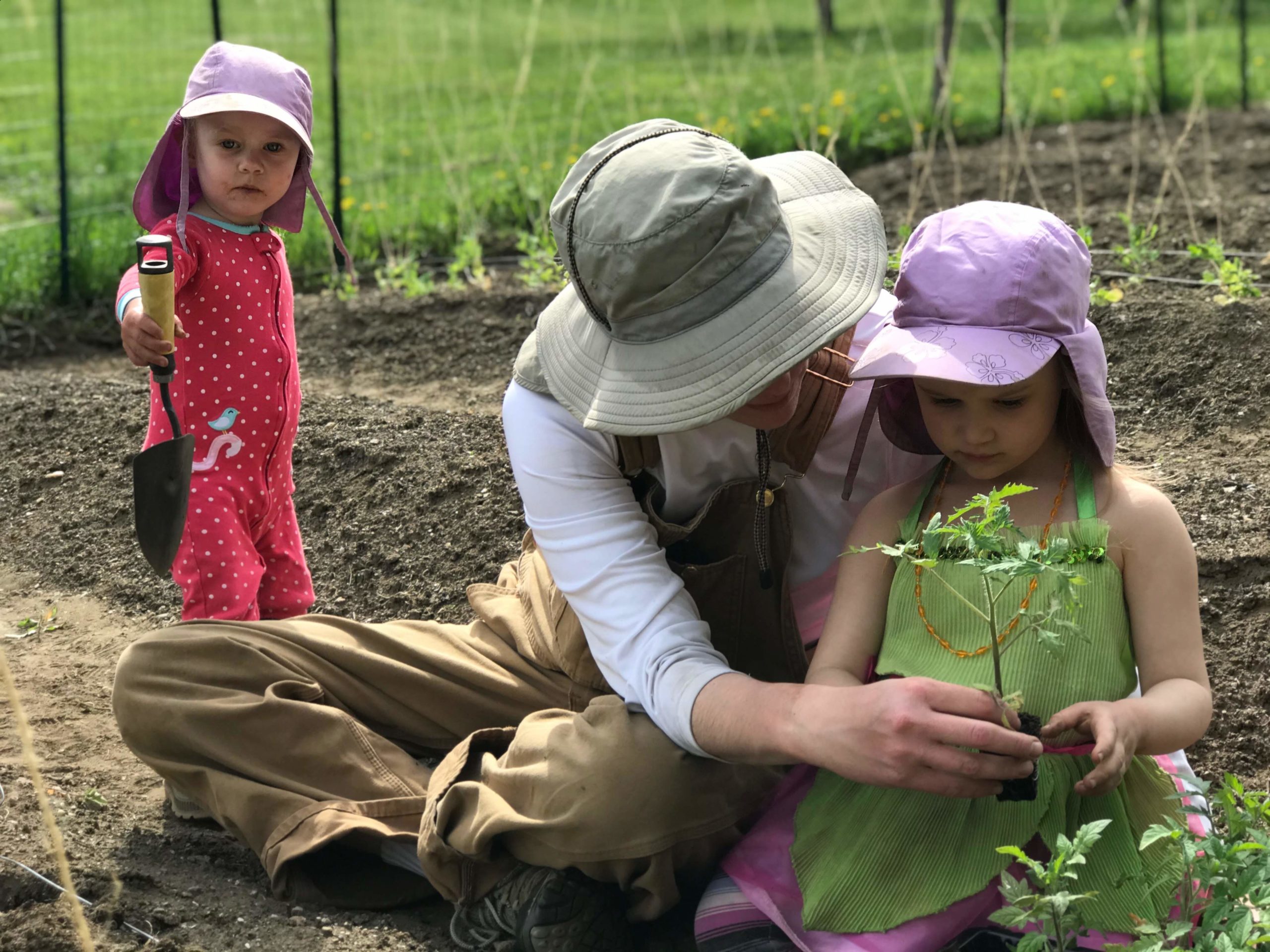
We built another garden. We can’t help ourselves. As I wrote last week, when sharing the cost of the dirt to fill them, Mr. Frugalwoods built four raised beds–each measuring 4 feet by 8 feet–and installed them next to the house.
Two of these beds will serve as our kitchen garden with leafy greens, herbs, plus a few root veggies and the other two hold a total of 100 strawberry plants. We’re amassing a retinue of garden areas that all need to be planted, weeded, watered and harvested. Why have one garden to neglect/kill when you can have six?!
Here’s our garden rundown:
1) The big veggie garden:
- Location: lower field, some distance from the house (technical demarkation).
- Style: no-till mounds. We tilled and mounded this soil three years ago and haven’t disturbed the mounds since.
- We leave plants in the ground through the winter, snipping them at the base in the spring, leaving the roots.
- We rotate veggies between mounds so that, for example, tomatoes aren’t planted on the mounds where tomatoes were planted the previous year.
- The beauty of no-till is that the soil supposedly grows richer while the weed pressure decreases. This garden was grass when we started and the weeds were horrific the first year. Now, I only have to weed once a week!
- Infrastructure: five-foot wire fence surrounding the garden; metal stakes for trellising on the mounds along with biodegradable rope twine.
-
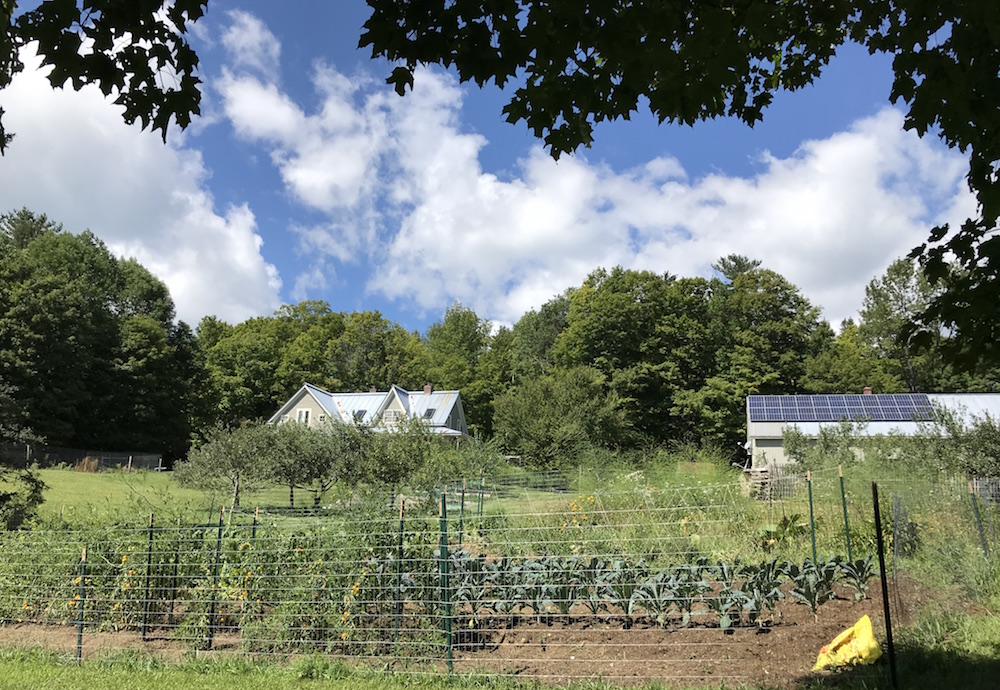
The big veggie garden two summers ago Size: 34 feet x 48 feet
- Plants (in 2020). We vary the types of veggies we grow each year since we’re trying to get as near as possible to growing (and preserving) our annual consumption. This requires blending our knowledge of what grows best here, what our family eats throughout the year (and in what quantities), and what veggies are easiest/best to process/freeze/can. Check out this post for a rundown of what we’ve grown in past years. This year we’ve planted:
- 89 cherry tomatoes
- 12 ground cherries
- 40 snap peas
- 12 hot peppers
- 5 cucumbers
- 23 bush beans
- 6 sunflowers
- Planting style: all these plants were started from seed indoors and kept under lamps for several months. After they’re hardened off, they’re planted.
- Tending required: planting, watering, weeding, harvesting.
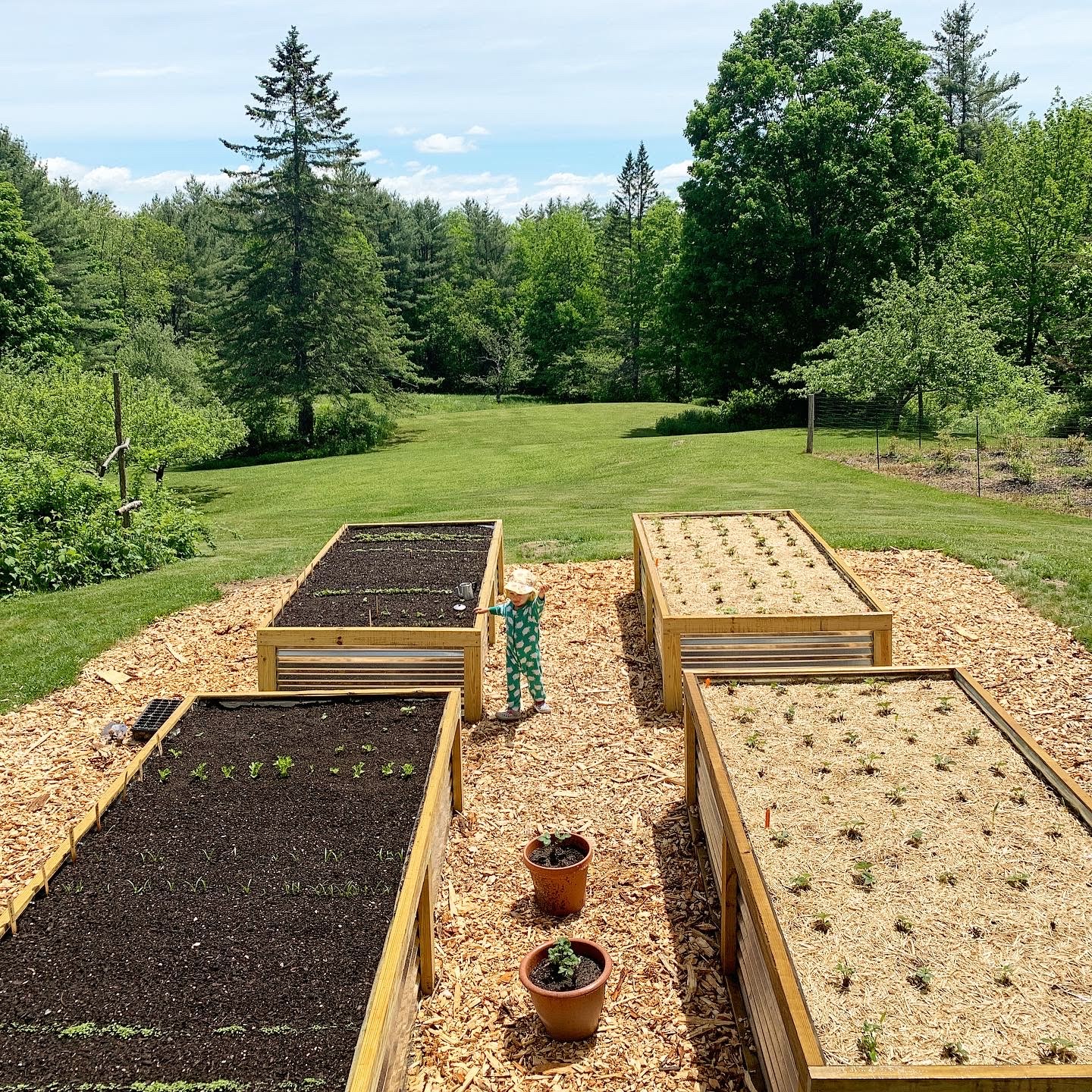
2) The raised beds:
- Location: next to the house, immediately off our back porch.
- Style: raised beds filled 1/3 of the way with old firewood (to reduce the amount of soil needed and provide a natural compost layer), with a 50% compost, 20% screened soil, 10% peat moss, and 10% sand mixture to fill.
- Infrastructure: pressure treated lumber and metal roofing panels. Weed fabric stretched between and around the beds topped with wood chips.
- Size: four beds each measuring 4 feet by 8 feet
- Plants:
- Bed one: 50 strawberries
- Bed two: 50 strawberries
- Bed three: arugula, spinach, lettuce, basil
- Bed four: dill, cilantro, oregano, sage, basil, carrots, radishes, mixed greens
- Planting style: a mixture of direct sown (planting seeds straight into the ground) and starts (starting seeds indoors, then planting little plants into the ground).
- Tending: planting, watering, weeding, harvesting.
3) The perennial berry patch:
- Location: to the right of our house
- Style: no-till mulched mounds for each individual plant, spaced several feet apart
-
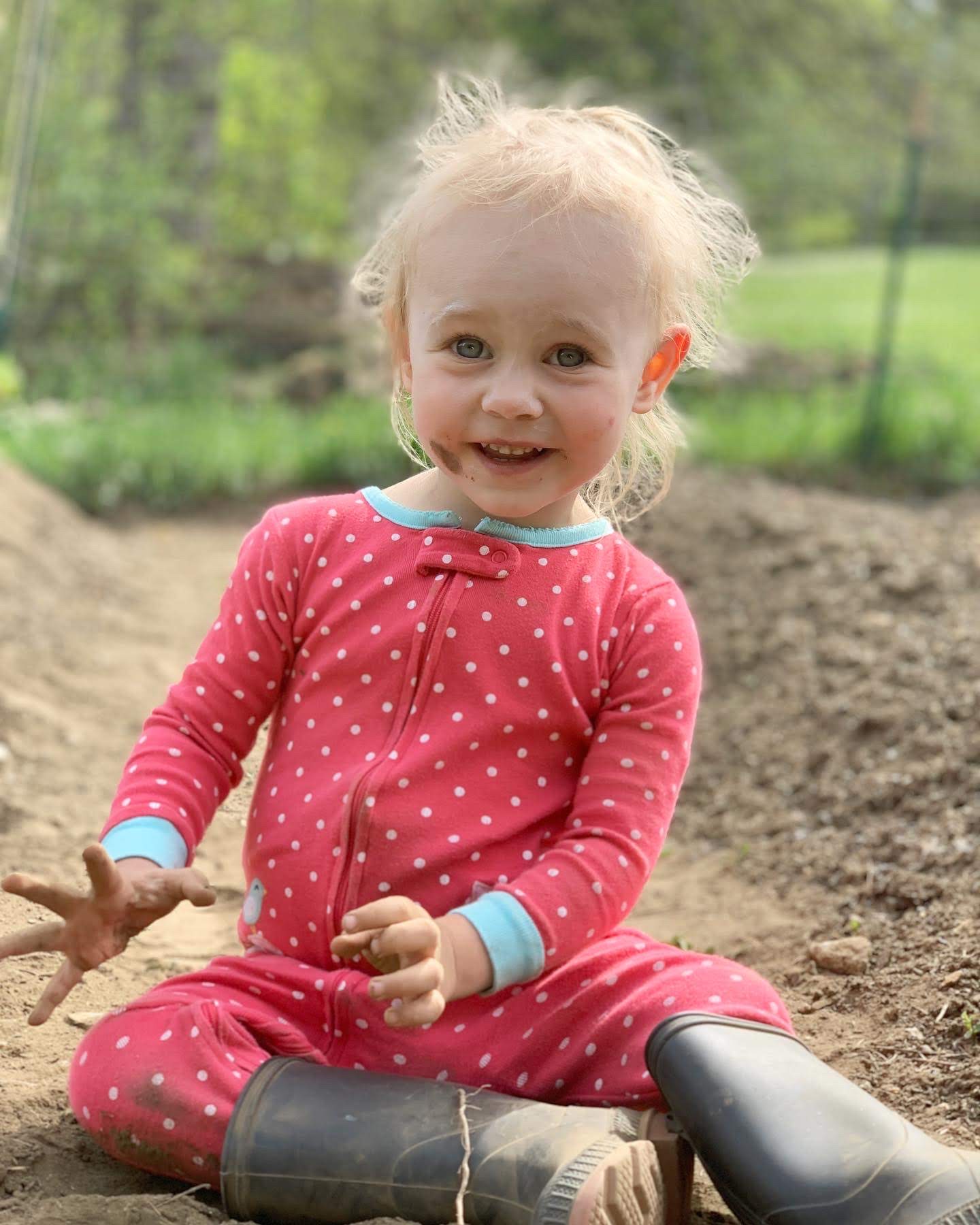
Super helpful garden assistant.. Infrastructure: five foot high wire fence
- Size: 41 feet x 70 feet
- Plants:
- 24 blueberry bushes
- 3 currant bushes
- 3 Haskap berry bushes
- 2 Saskatoon berry bushes (the third one died)
- Planting style: the berries are perennials, meaning you only need to plant them once and they’ll bear fruit every year. We planted these berries as tiny bushes three summers ago and they’re looking great (except for the Saskatoons–one died and the other two are still really small).
- Tending: watering (seldom because blueberries prefer the acidity of rain water), weeding, harvesting, and mulching around the mounds as needed.
4) The cherry-and-pumpkin patch:
- Location: mid-yard
- Style: weed fabric topped with mulch; plants interspersed
- Infrastructure: wire cages around each cherry bush
- Size: 22 feet x 24 feet
- Plants: this section is a mixture of perennials (cherries) and annuals (everything else):
- Two Juliet cherry bushes
- Two Carmine Jewel cherry bushes
- Six pumpkins
- Four cantaloupes
- Four watermelon
-
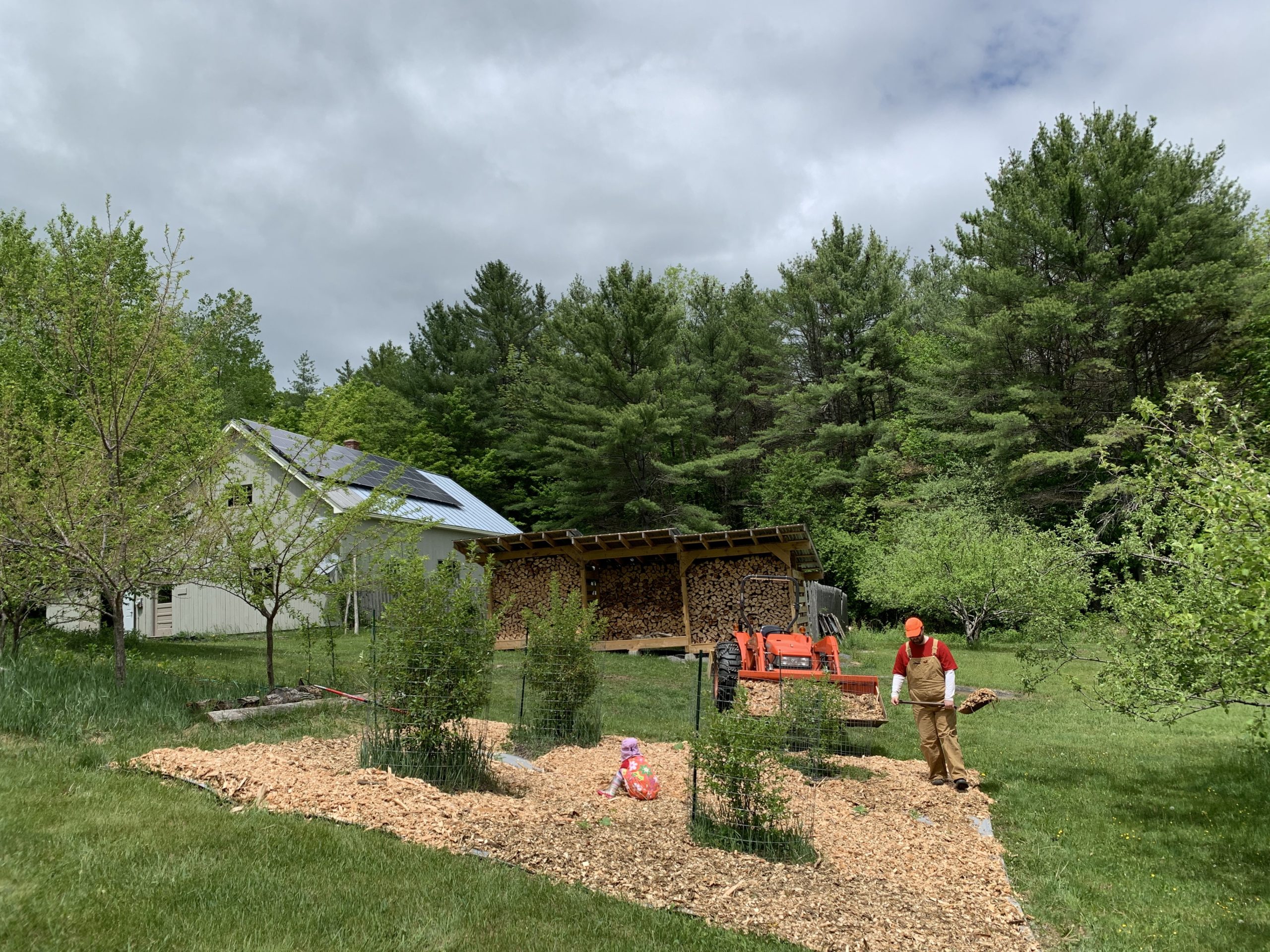
Mr. FW and Kidwoods adding wood chips on top of weed fabric in the cherry-and-pumpkin patch Planting Style: we planted the cherries as tiny bushes three summers ago and they’re all doing well. The pumpkins, cantaloupe, and watermelon were started from seed indoors and transplanted into the dirt in late May. So far, the pumpkins look great, but I’m not sure the cantaloupe and watermelon are going to make it.
- Tending: planting, mulching, watering, weeding, and harvesting.
5) The fruit trees:
Three plum trees and ten apple trees were here when we moved in and we’ve done our best to keep them alive and producing. The main thing these trees need is pruning in the springtime and pest mitigation, which we do through periodic applications of the organic, clay-based pest deterrent called Surround.
6) The berry vines:
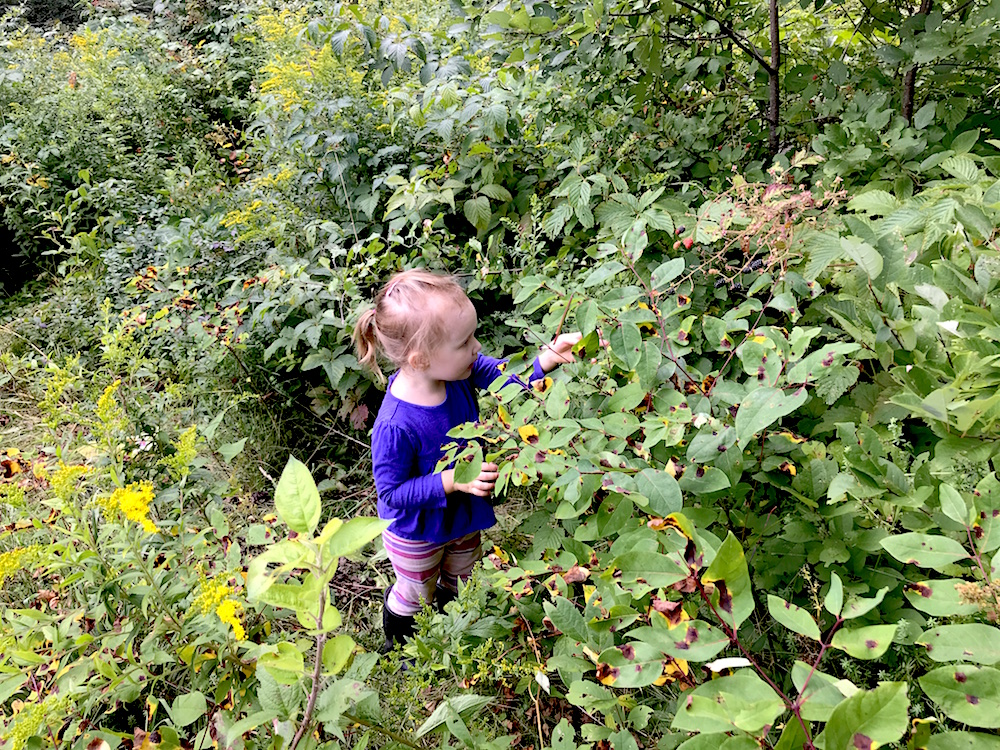
We have two perennial berry vine tangles: black raspberries and blackberries. The blackberries are full-on feral, but I crash through them like a bear to harvest every August. The black raspberries are on the cusp of tame, but they do their best to resist Mr. FW’s trellising and pruning ministrations. Basically they’re both thorny messes, but the berries are delicious (if you can get to them).
7) Future plans:
You didn’t think we’d stop at six did you? Not masochists like us. We have vague plans for planting elderberry bushes, more currant varieties, peach trees that can survive the tundra, and anything else we can think of/get our hands on.
Going From Grass to Garden
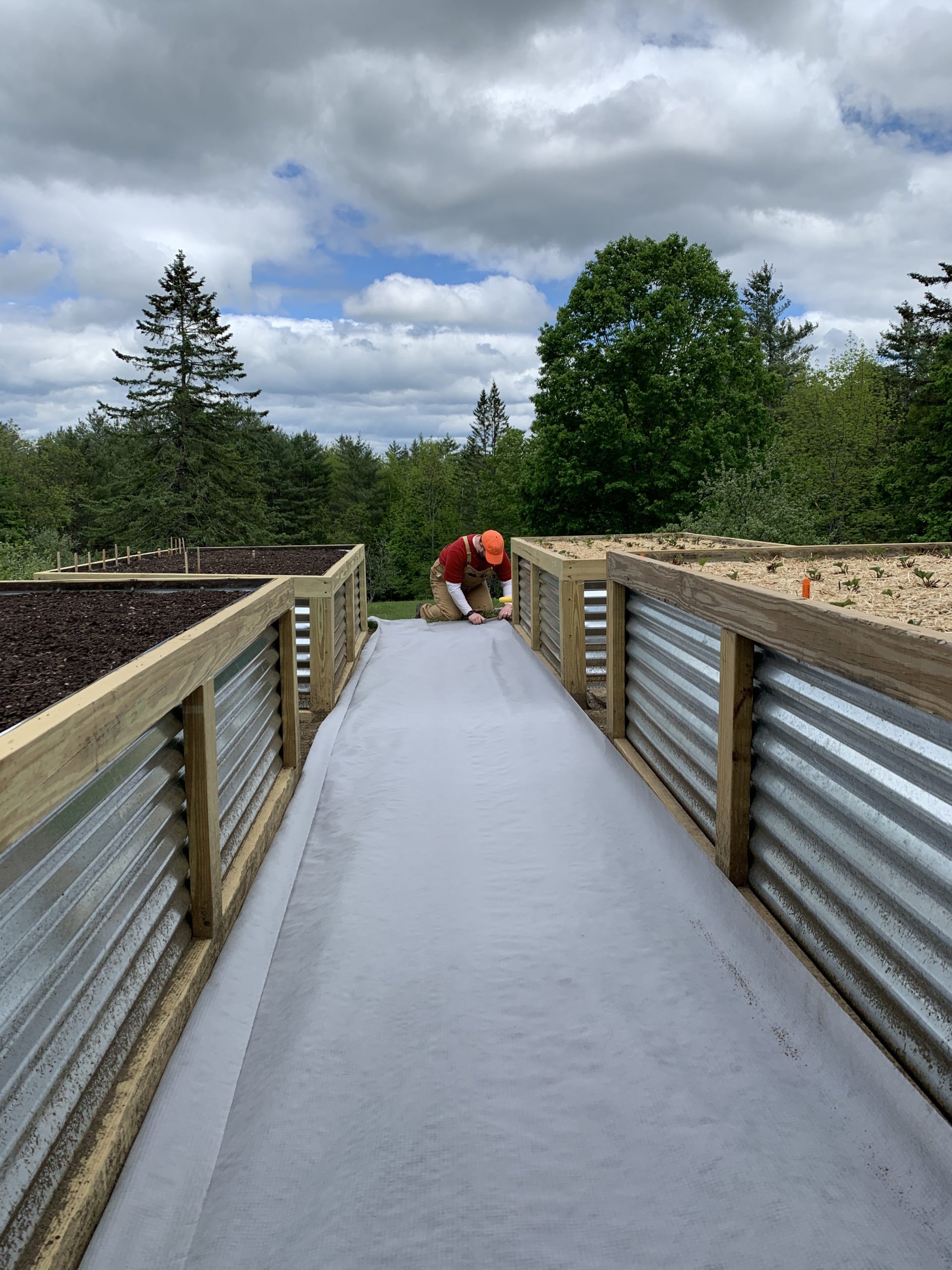
In all of these instances–save the existing plum and apple trees–we converted grass into garden, which makes for an uphill battle against weeds. When we moved here four years ago, we decided to try and reduce the amount of lawn we have and increase the amount of food we grow–in particular, perennial foods.
We are slowly (very slowly) working to build a sustainable permaculture homestead where we grow as much of our fruits and vegetables as possible. We have zero plans to sell our produce, but lots of plans to sustain ourselves and have food to share with friends and neighbors.
This year for the first time, we’re trying out weed fabric topped with wood chips as a weed-mitigation method. Over the years we’ve tried many weed combat tactics including: mulching with cardboard, weedwacking, flame weeding (memorably), and hand weeding. My hope is that the weed fabric will be a more sustainable system and require less hand-weeding.
To that end, Mr. FW used the tractor bucket to remove the sod from the area under the raised beds. After setting, leveling, and filling the beds, we stretched weed fabric between and around the beds and put woodchips on top. Our hope is that the grass will be slow to reconstitute around these beds.
Mrs. Frugalwoods: Spotted In The Garden, Planting Stuff
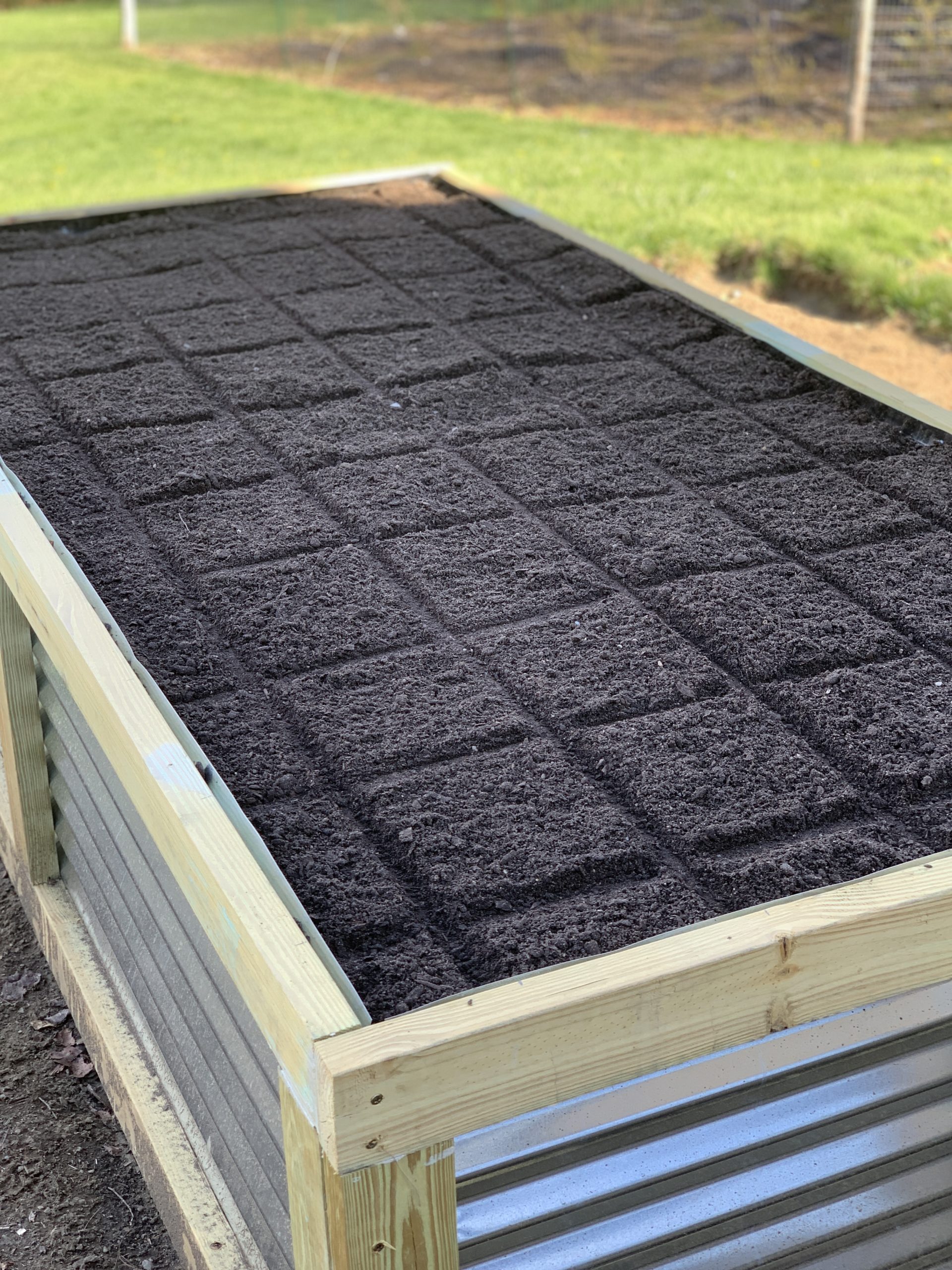
I planted the 100 strawberry plants by myself. I’ve lived here for four years and this is the first time I’ve felt ownership over our garden because, until this year, I’ve been pregnant or nursing or herding tiny children. I mean, they’re still tiny, but that’s an advantage because the raised beds are too tall for them to reach into (although it appears they keep growing… ).
I planted the first few strawberries while the girls played in the yard, the next ten with Kidwoods’ help, the next two were ripped out by Littlewoods (replanted by Kidwoods), and I planted the final 80 while listening to The New York Times Daily podcast.
I’m blending my life. I’m finding the balance between urban and rural because I’m not either. I’m out here on 66 acres with the city in my ears, the earth under my nails, and both swirling inside me. I’m equally at home in both; I’m equally uncomfortable in both.
I am proud of these strawberry plants. I’m grateful to my engineer husband for building these raised beds, calculating the distance required between berry plants, measuring that distance, and graphing it out in the dirt.
After all four raised beds were built, installed, and dirt-filled, I, the garden grinch, planted all four by myself. After planting the strawberries, I realized I wanted MORE dirt to my name.
So I was the one to seed the arugula, carrots, salad greens, spinach, radishes, cilantro, dill, and all the rest. Really this is just an opportunity for me to vent my desire for control and regulation. I measured the row distances, I marked them with a board, I used a pencil, I had a back-up pencil, and I only had to take apart one of Kidwoods’ art creations to commandeer the requisite number of popsicle sticks for my intense (obsessive?) labeling system.
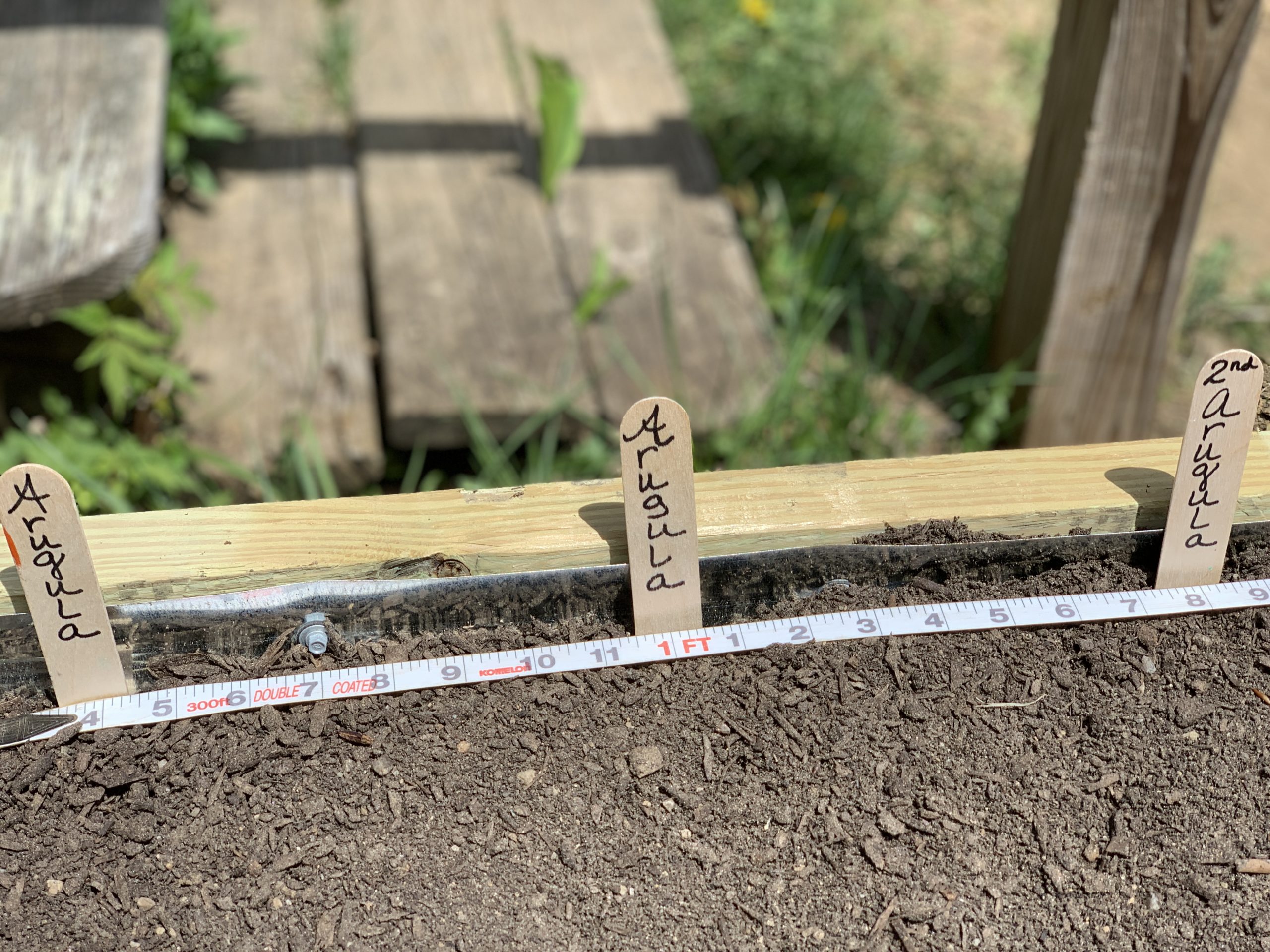
I am exhausted and dirty and not sure how we’re going to keep all of this alive/harvested/preserved; but for the first time, I am living the life I think I was meant to live. Because of the pandemic, I’m not going anywhere. Because of the spring, being outside is the best option.
And because of my age, I am really committed to the radishes I’ve planted. I always wanted to be into gardening and I’ve always wanted to be more “sustainable,” and now, I’m finally doing it. We’re growing more food than we ever have (which probably means we’ll kill more plants than we ever have), and I go to bed yearning to plunge my hands into the dirt again. As a person who used to do weekly DIY manicures, I assure you this is a new leaf.
Weeding = Path to Enlightenment?
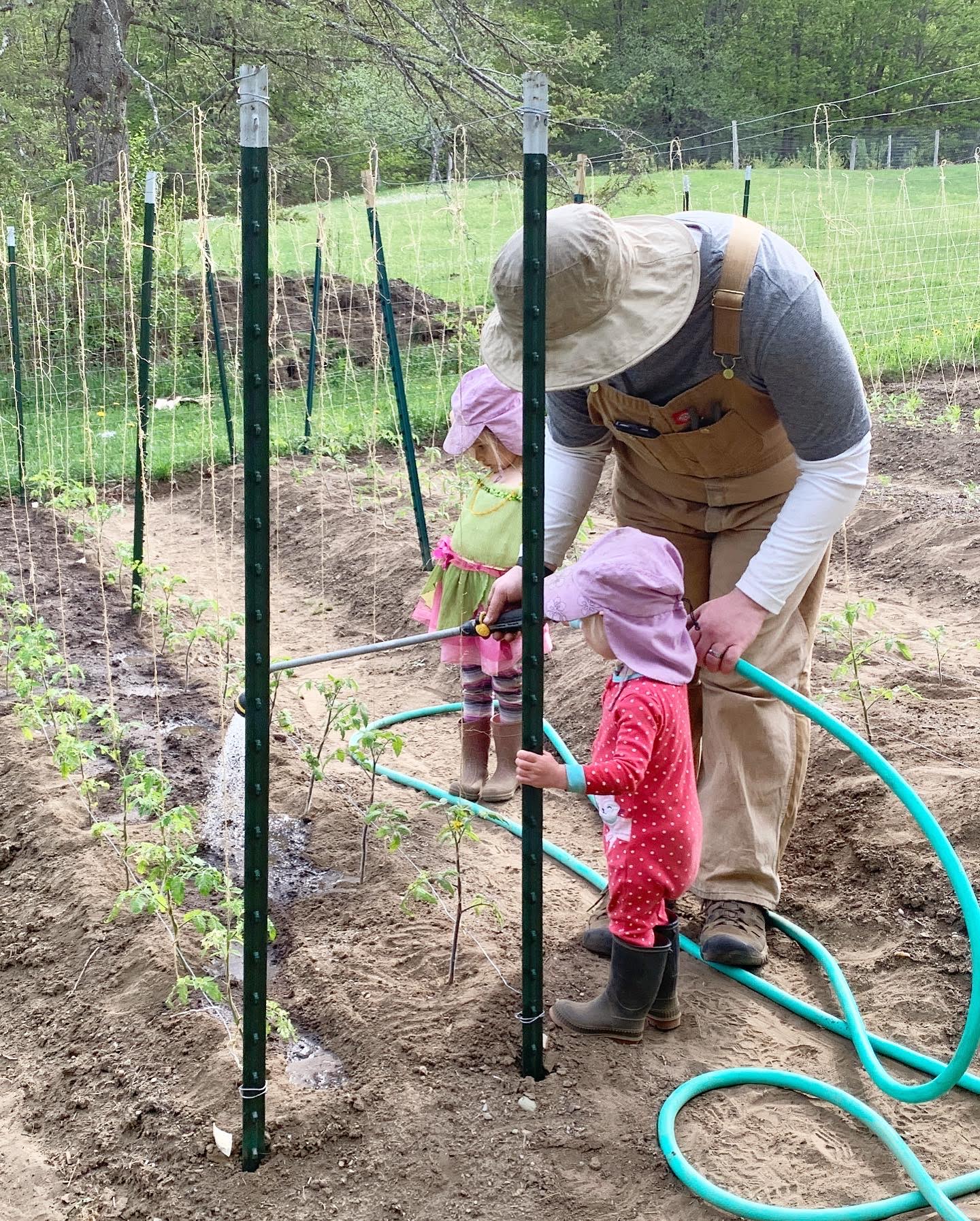
I am drawn outside more and more. My husband and kids are out there–trying to accomplish stuff/trying to keep daddy from accomplishing stuff–while I’m inside cleaning, vacuuming, crumb-wiping, dishwasher loading, laundry-putting-away. Until finally, I go out. I dump the compost (with extended assistance from a two-year-old), sweep dirt from the porch and then sink into the blueberry patch to weed.
As I pull weeds, I realize there’s nowhere else I want to be. I dig into the dirt with my fingers, my nails, to get underneath the roots to ferret out each weed at its core. I have weeding implements–spiked and metal–but I rarely use them because I’m terrified of disturbing the blueberry’s shallow, fibrous roots. I sit in the warm dirt, close my eyes, and pull weeds by feel.
My husband trellised our black raspberry vines in May while the girls prepared mud pies and cups of “tea,” for delivery to their toiling parents. There was bliss in this shared labor, in our desire to grow more food on our land, in our commitment to berries (apparently we love them), and then, someone needed a snack, another person required a diaper change (wasn’t me, I swear), and my eyes flew open, I launched out of the patch and back into the day.
But those plants are there for me. I can sink my hands into soil and feel something other than computer keys and a phone screen and crumbs on a counter anytime I want. There will always be more weeds to pull, which is either infuriating or the path to Zen enlightenment.
Strawberries: Apparently They Need Straw
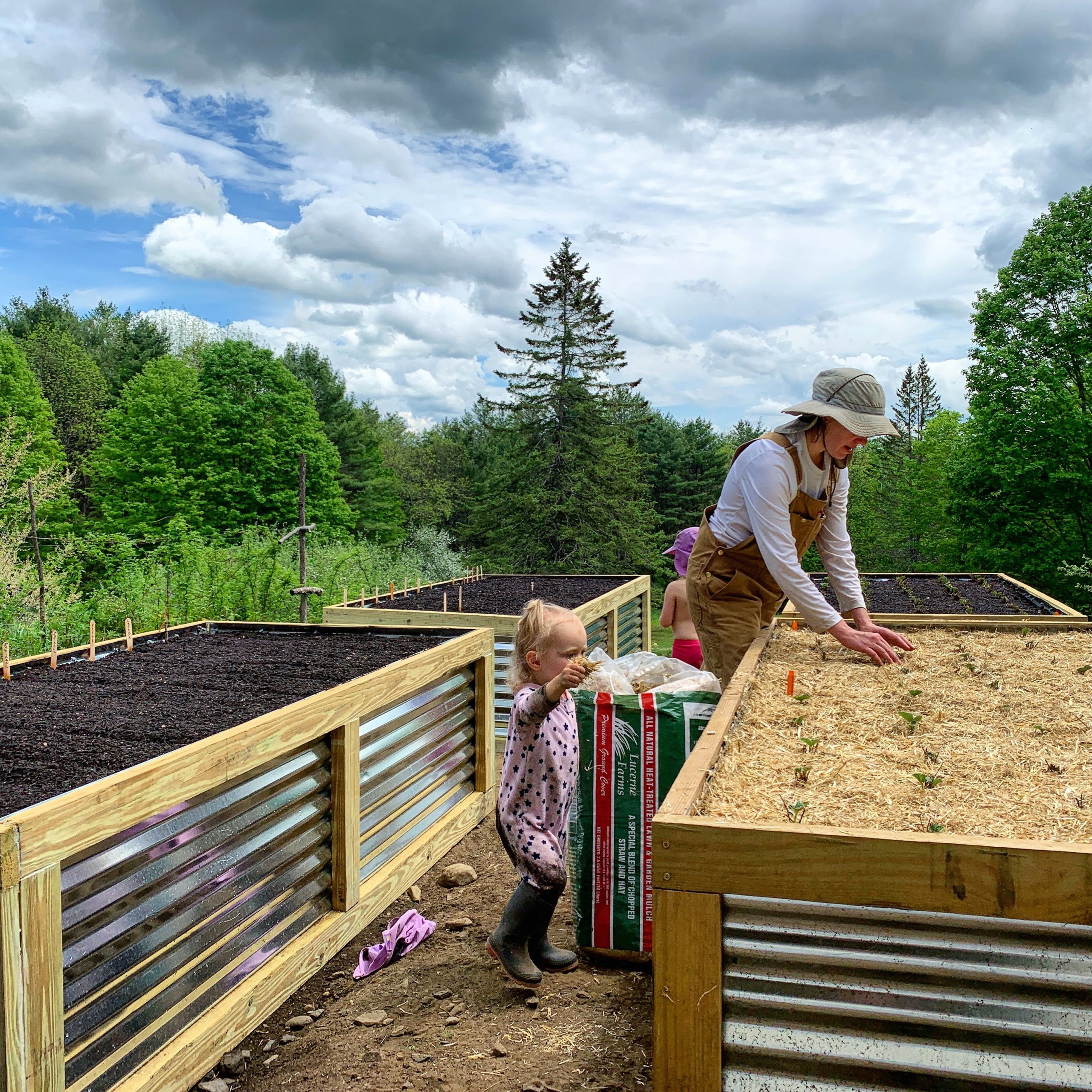
I did not know–until after planting the 100 strawberries–that they require straw to keep the fruit from rotting. It is super useful that my husband did know this and had a bag-o-straw at the ready. Turns out, spreading straw is right at the skill level of toddlers. They plucked straw, threw it in their faces, and smashed it down on the strawberry plants, which (mostly) looked alright after this aggressive straw application.
It is so hard to grow stuff. Toddlers included. Kidwoods’ latest phrase is “Nothing bad will happen!” exclaimed over her shoulder as she runs upstairs/outside/into the woods. Most recently, I was told this as she demanded to dress herself and her sister and, 25 minutes later, they came downstairs both fully dressed.
Yes, Kidwoods had on a swimsuit, cardigan, pants, and skirt, but Littlewoods’ outfit was remarkably restrained at one shirt and one pair of pants.
Seems I’ve been so derelict in dressing my children they now do it for themselves, which means my life plan is realized. I’ve dropped the rope and my kids have picked it up. What I don’t do for them, they figure out for themselves. Or they just scream until I come see what’s wrong. Effective either way.
Update: Then I Removed All The Straw
So we bought expensive, supposedly weed-free “heat-treated” straw, which I will tell you was not cheap. Per the above, I laboriously spread straw around each and every strawberry plant, thinking myself the epitome of garden goddess. Two weeks later, it looked like I’d sown grass seed into my strawberry patch. This straw was not weed-free, not heat-treated, and instead turned out to be the equivalent of sod. Cool. So, along with my niblet assistances, I laboriously plucked the straw back out of the strawberry beds and dumped it on the compost pile. The strawberry plants will just have to learn to live without their namesake.
Happy Mother’s Day to MEEEEE
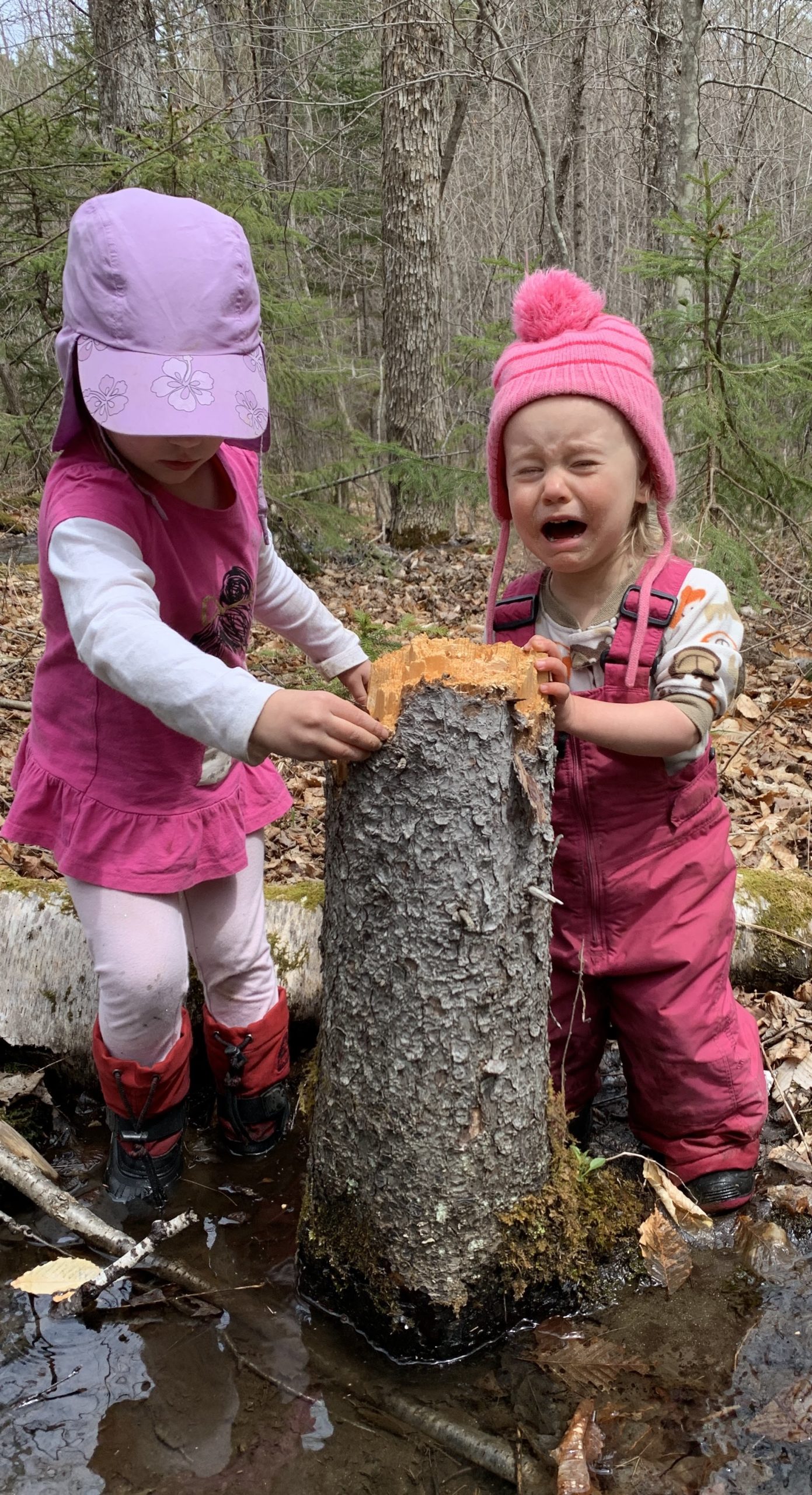
From my children, “Happy Mother’s Day to you, we are fighting over a tree stump in a forest of nine hundred thousand tree stumps.” Yay!
Tree-stump battles aside, Mother’s Day was glorious. I sang a solo for church (it’s via Zoom, so their music options are limited; hence me), my husband made cinnamon rolls FROM SCRATCH–only took him 7 hours, were the best cinnamon rolls I’ve ever eaten.
We played outside, my husband baked a ham and whipped up from-scratch biscuits for ham sandwiches, I cleaned the bathroom (don’t judge, we all make our own happiness), talked with my mom and mom-in-law, enjoyed some adult juice (margarita made by my husband), received a card from Kidwoods in which she wrote her name and “Mama,” witnessed my girls eating ham with wild abandon, breathed deeply in our woods, and was really, really grateful.
Also, after twelve years of marriage, it’s clear my husband knows what I want for holidays: all the foods.
Solar Check
After moving here, we decided to have solar panels mounted on our barn roof. My full write-up on the panels is here and I include a solar update in this series. This is the only way for me to remember that: a) I have solar; b) you all would like to be updated on it.
In May, we generated 887 kWh, which is good times. For context, in January 2020 our panels generated 120 kWh and in July 2019 we raked in 907 kWh.
Since our electric company offers net metering, we’re able to bank our summer and fall sunshine for use in the winter, which keeps our electric bill low year-round, even when the sun isn’t shining. This has been your solar production update. You’re welcome.
Want More Fotos?!
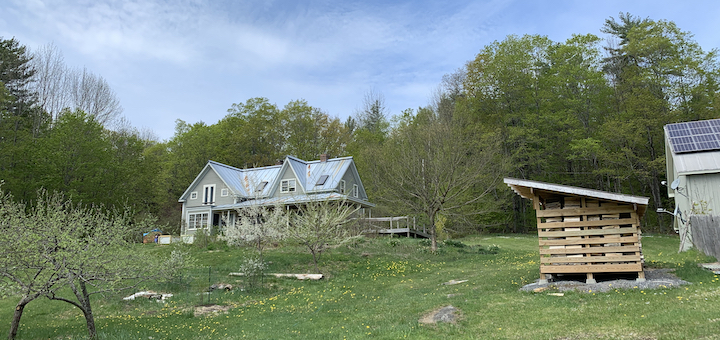 While I only document homestead life once a month here on the blog, I post photos to Instagram (almost every day!) and updates to Facebook with much greater regularity.
While I only document homestead life once a month here on the blog, I post photos to Instagram (almost every day!) and updates to Facebook with much greater regularity.
Join me there if you want more of our frugal woods. Some folks have asked about this and yes, I do try to post a picture to Instagram every day and–unlike with many other things in my life–I have a pretty good track record.


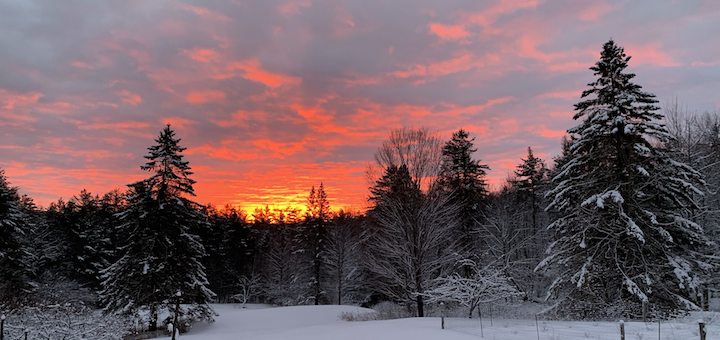
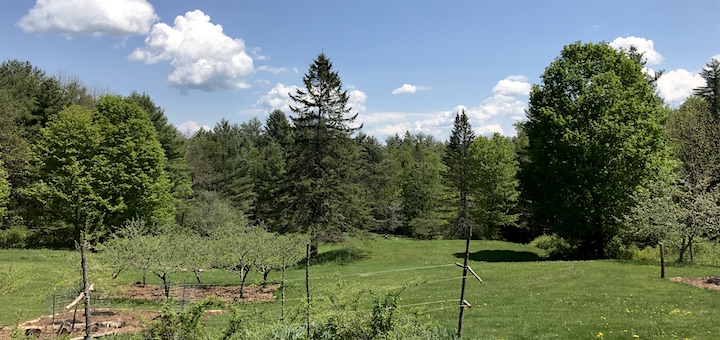
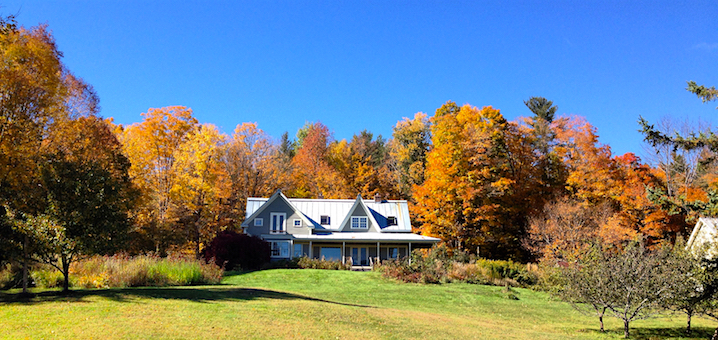
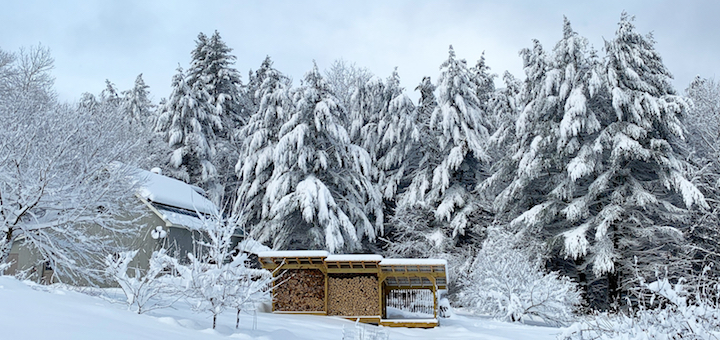
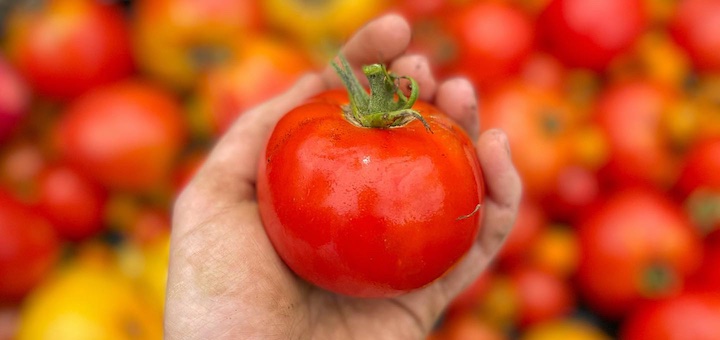

Do you have any specific references for guidance on setting up a garden (books, websites) that were helpful ? Looks amazing
Thank you! We’ve read tons of stuff about gardening over the years, but the most useful information is specific to our region and zone. We’re in USDA Zone 4a/4b, so anything not related to our zone isn’t all that helpful to us–the best resources are our neighbors who’ve been gardening in this climate for years. The pest pressure, the weather, the soil—all of that makes a huge difference. So while there are useful general gardening tips you can follow, anything you can find that’s tailored to your region will be the most helpful. Extension schools are fabulous resources. The other important thing is to buy good seeds–we get most of ours from a Vermont company, High Mowing Organic. Good seeds, good infrastructure (heat lamps and mats if you’re starting seeds), and then vigilance about watering and weeding will go a long way :). I hope that helps!
Thanks for this amazing gardening post!
For four season gardening in Zones 4-6, check out Niki Jabbour, who grows year round in Nova Scotia, Canada: https://www.growingagreenerworld.com/1013-the-year-round-vegetable-gardener/
I have her book, The Year-Round Vegetable Gardener, and it has been amazing for my setting up my winter garden.
Meg Cowden in Michigan also has great tips for season extension: https://www.growingagreenerworld.com/1012-from-seed-to-fork-growing-an-abundant-and-beautiful-cold-climate-garden/
And Elliot Coleman in Maine is also definitely one to check out! Eliot became acquainted with the authors of the one and only “The Good Life” (by the Nearings), often cited as founders of the simple living movement from the early 20th century, two original American minimalists or FI pioneers, one might say.
You can check with Storey Communications. They have great homesteading books. Also check out the Square Foot Gardener. https://www.storey.com/
Wonderful start to the growing season!
Saw that grid and those rows and thought “so much soil still exposed at full growth — has she met Biointensive yet — she might enjoy that”. Key resource is book “How to Grow More Vegetables” accessible over at http://www.growbiointensive.org/. One idea from Biointensive is to plant en masse (really on hex grid) closely enough that full-growth plants will form a full canopy to shade the soil, keeping in water and keeping out weeds.
PS Self-teaching materials at http://www.growbiointensive.org/Self_Teaching.html — the first PDF (16-page) distills the approach wonderfully.
Thank you for sharing that link, Joseph.
Thank you!
Thank you Joseph! 😊
Love biointensive. Did this by accident with my raised beds because I wanted to keep as many of my seedlings as possible.. grow more now pull more as seedlings run out of space!
What a fun post! We are looking at starting a garden next year on our little urban homestead. We just moved in last month so too late for this year–this year we are just prepping the yard, which had been a bit neglected.
My husband keeps saying how much he is looking forward for our son to help him in the upcoming years, our son is now 6 months. After reading your posts I know enough to tell him to temper his expectations :).
Looking forward to seeing how all your plants do!
Hahah, yep. For us, it’s looking like age 4 is the magical garden age: she can plant, weed, and harvest this year!
Are you worried about using pressure treated wood in the garden beds? Also, cantaloupe and watermelon do not like to get their roots disturbed to much so only start 3-4 weeks before planting out, 2 weeks after last frost (Mid June!) sow every 2 weeks until beginning of July and choose short season varieties.
Was actually going to comment that I was happy she’s using PT. That’s what we have and for 7 years haven’t had an issue. They don’t treat it with arsenic anymore I believe that’s wood from 2006 or older though full disclosure I never checked what age ours were- so far just delicious veggies without any chemicals to treat for bugs. Fertilized with compost/worm tea.
Like you, the more time I spend outside the more I want to be outside. I live in the city, so not the beautiful countryside like you do, but I’m lucky I can frequently escape to my boyfriend’s and family’s suburban homes. Over the years, I’ve made meager attempts to plant herbs, fruits, and veggies on my deck, but my neighbor’s cat likes to eat nearly everything I plant! My gardening skills are mediocre at best, but I still try. 🙂 I love reading these posts!
We also live in the city and have cats as our garden’s primary enemy! This year we’ve had good luck tucking handfuls of holly leaves around the plants. The leaves are spiky so they deter the cats from getting close, lest they prick their paws. Fortunately we have a giant holly bush so it was a free solution! But I imagine if you find a neighbor with a holly they wouldn’t mind sharing a branch or two with you.
We live in a condo now, which reduces my “garden” to a series of pots. My zucchini and cucumbers look good as does one of my pots of chard, despite the fact that an industrious squirrel dug into and re-arranged the seed randomly. Another pot of chard received the squirrel’s attention and is now partly planted with stunted plants and partly re-seeded in hopes that the squirrel will be too tired from all of the previous work to do more re-planting.
Why have one garden when you can have six? My thoughts exactly!
My 17-year-old built me a raised bed for Mother’s Day so I could grow more flowers. Mind you I have multiple flower beds already and space in our vegetable garden to grow flowers but I can’t help myself.
Isn’t gardening one of the best relaxations? Never thought I’d say this but I probably get out of my head more when I’m working outside than when I do yoga.
We are also experimenting with weed fabric this year and so far, we’re loving it. Husband has wanted to try it for years and I’ve resisted but we can’t do everything and it seems to really be making a difference.
Glad you were well-fed on Mother’s Day!
Thanks for all of the pictures. I no longer garden. Keep thinking I might do a raised bed just for salad goodies, maybe next year. Has become way too hot now in south fl for any gardening. I will enjoy for now through your posts.
My big garden days are behind me, but I remember them well, and my grown kids sure do. By the time they got old enough to be real help, they were trying to hide when it was time to work the garden. But, we got them out there, and now they laugh about pulling weeds, snapping beans, and fertilizing tomatoes. None of us laugh about our many times of encountering fire ants in the garden, but, that’s another story.
Today I just have a container garden, but it is still fun to go look for cherry tomatoes, find the hidden squash or cucumbers, or watch the okra start to unfurl its showy blooms. Just a side note, okra plants have very attractive blooms, even if one never eats the pods. I doubt okra is much of a garden choice in Vermont, however. And I don’t have a bunch of weeds to pull anymore. I think you’ll love those raised beds because of the lack of weeds, once you kill off the weeds from the straw, that is.
I’m eagerly waiting to see if you build a greenhouse, so you can garden more of the year.
A garden is always a product of hard work, good advice, plant wisdom and sheer luck. You have the hard work nailed, are getting good advice, and are obtaining more plant wisdom every summer. So now if the luck will hold out for you, you should have a fantastic harvest this year!
We did okra last year and it just didn’t do all that well, which was a bummer! We talk about a greenhouse all the time… we shall see 🙂
The beds are gorgeous; great job!
Do you use any kind of garden planner? I’m thinking of subscribing to the one at growveg.com. Just not sure I can keep track of everything in my head/on notes.
We use a spreadsheet to track everything, which seems to work pretty well so far.
I like flower gardening, but get tired of dragging the water hose around. Do you have a water source at that lower garden bed, or just a super long hose?
A super long hose that’s a major pain to drag around, but I just tell myself it’s a good workout!
Right now I am suffering from envy Mrs. Frugalwoods! Something I actually never feel…..The idea of growing food is intriguing but I’ve never so much as had a tomato plant…..On well….we live on the water…and in theory I suppose we could try and get fish and crabs, only problem is I’m a vegetarian!
I’d love to hear more about composting! I feel a bit sad throwing away fruit and veggie scraps but am soooo afraid of compost failure, I.e. bugs, rodents, stink.
I took a local composting series of classes at our Civic Garden Center. Maybe you have something similar in your area. I use composting tumblers (four) and rodents are not a problem. If you have the correct balance of greens and browns it will not have an odor. There will be certain insects in your bin at certain times but that is good!
I love my compost bin–honestly, it feels as magical to “grow dirt” as it does to grow veggies! If you have an enclosed bin (you can buy ones that tumble, but I just had my handy husband build me one that has removable planks so that I can take the finished dirt out from the bottom without having to take the unfinished compost off the top first) any failures you have will be easy to correct. If it stinks, your balance is off and that’s easy to correct (you can read about brown/green balance on the internet, but I don’t work that hard–I just make sure it gets enough grass clippings from a neighbor, which seems to make all the difference for my bin and creates the right heat balance). And the lid of the bin keeps the rodents out (though there’s nothing to be done about bugs–they’re a part of the process!), and the moisture in. Make sure to toss things every once in a while and make sure it’s noticeably hot (the grass clippings really help mine heat up), so you know the composting is happening. You might have a little trial and error, but it’s definitely worth it–it’s so good for the environment and really amazing to make beautiful rich soil for garden beds or your yard!
So true. I use 4 parts of dry material + 1 part of humid material + 25% of used coffee grounds. No bad smell, no flies, no cockroaches, no mices. It was a leap of faith. But it works,
Gardening is my peaceful time (even before the pandemic). We have a few veggie gardens in the back yard (nothing as impressive as yours) but my main joy is the huge perennial garden in the front that I am gradually remaking to be more pollinator and native friendly. Have you thought about starting some pollinator habitats? They would need a bit of attention, watering and weeding in the first couple of years while they got established, but then they’re exceptionally low maintenance, and so beautiful. You could pair host plants for caterpillars with feeder plants for butterflies and create waystations. We support monarchs and swallowtail butterflies through all their life-cycle stages in our garden.
My other thought with the area around/between your raised beds is you could put in a native ground cover that would fill in the whole area and stand up to foot traffic. A native clover is an easy option- you don’t have to mow it, and the flowers are important food for bees. I think creeping thyme is another one, but I’m not sure if it would stand up to the foot traffic (I’m in Ontario, so my zone is similar to yours, although I’m a 5a). You probably have some neighbours with beautiful gardens who could help.
I’m pretty sure you’ve said on here outright that you were going for food rather than flowers, but maybe I can convince you to think of flowers as food for all the pollinators that you want to attract to your garden to help grow your food!
I second this. In the past year or two I’ve actually focused more on planting perennials that are pollinator friendly. I’ve noticed more bees, moths, hummingbirds, butterflies, dragonflies, etc. We had a lot of bees disappear one year, and I’ve been trying to provide more sources of food and water to help rebuild their numbers. The more I have, the better my yields tend to be on my food plants. It took awhile to find milkweed in my area for monarchs, but now I have it. I was so excited to check on my monarch and swallowtail caterpillars last year! Of course, I don’t have nearly as many food plants to look after as Mrs. Frugalwoods does. 🙂
We inherited a very large flower garden (planted by a previous owner) and have fields of wildflowers, so we feel very fortunate to have lots of pollination action!
Critters? Not kidswoods, of course, but squirrels, deer, rabbits? How are you keeping the squirrels from decimating your fruit and berries?
We have deer fencing around our garden and “orchard”, planting only in raised beds for veggies due to an unrealistic number of gophers (wth? how many babies a year are they capable of???????), but the squirrels are decimating our fruit trees year after year. Even with cages, netting, and all sorts of interesting things my engineering husband concocts.
Please help???
The squirrels are busy denuding my pear tree right now. The fig trees will be next, as soon as they ripen. If you find a way to deter them, please let me know!
I’ve just been reading Monty Don’s book ‘Down to Earth : Gardening Wisdom’, & he mentioned pruning blackberries & raspberries in order for them to produce more berries, & for those berries to be more accessible. Sorry I can’t give the details, as book was returned to Library a couple of days ago – I do remember there were different instructions depending on whether you have summer or autumn fruiting bushes…
Yep, we prune them and remove the dead vines, but they’re still outrageous 🙂
Wow! I love all your planting areas. Congratulations on doing the solo for church – even if it was on Zoom since many professionals are doing Zoom concerts. I love the pics of the little ones enjoying/crying – life is always better with a few of them around.
Not sure if you knew it or not but your raised beds sound a lot like the hugelkultur method. Really cool!
Yes! That’s what I was thinking. I just found out about hugelkultur, and I built my first one this year since we had some old logs that wouldn’t really work for fire wood.
We have never used straw . Amish will use cedar wood chips.
Are you considering writing an article on your awesome raised garden boxes? Or maybe I missed it? Would love to know how to build them. Very attractive!
I definitely second that, Mrs F!
I’ll ask Mr. FW–he was the designer and builder :)!
Yes, we would love to know as well. We have raised beds that are rotting away and need to be replaced. My husband did not want to use pressure treated lumber when he built the original ones. I’m curious if the metal that Mr FW used isolates the pressure treated lumber from the soil.
Thanks for sharing your gardening month with us! Gardening is the best therapy out there! Watching all the things grow- I’m envious of your space and multiple gardens. I like berries the best, because they are so low maintenance compared to a lot of the plants. We now live on a small lot in town, so I’ve given up a lot of the things that we used to have at our farm (think raspberry and blackberry brambles). But we have two apple trees, 3 fig trees (two come inside with us each winter), a grape vine, hops, and an asparagus plot our neighbors envy. We also have okra (which we both love) and our container gardens for the herbs/ tomatoes/ kale/ chard/ sugar peas/ garlic/ beans. This year I finally tamed the grape vine I planted my first year here (my rule is: first year anywhere, plant asparagus and grapes- I’ve left them scattered behind me!) so now we have an arbor- I’m really hoping to get some actual grapes. Being limited to being at home, I’ve decided that this is the fall to learn how to make wine/ beer. Probably I won’t get enough grapes for wine, but the hops are going crazy at least!
Do you happen to have a spreadsheet for gardening records? Where you planted, how many plants and what varieties each year? I have been searching the internet but haven’t found a template I like yet 🙂
We just moved back to the country after 7 years in the city. I am loving getting my hands on the soil again. I have 3 kids ages 3 and under so I totally understand their desire to help with EVERYTHING 😂
Google Ruth Stout….she is the great-godmother of low work composting, mulching and gardening methods!
Kelly Marie, don’t be afraid to compost, it’s so easy and so very rewarding! You’ll need “brown” (dried leaves.) and “green” (kitchen scraps –it’s good to cut ’em up small– and green foliage from yard trimmings), and water. Oh, and something to put it in or corral it, and a pitchfork or something to turn it with. You should have about at 2:1 ratio of brown to green, and it should be about as moist as a wrung out sponge. (Water it if need be.) If you build it, the worms will come! There is no ”stink”, just a lovely aroma of damp earth. I had my bin for about 15 years before we spied an unwanted critter, so we decanted the bin, and added a wire mesh to the ground. About 1/2 inch mesh, I think . That did it! I love making soil with my worms and Mother Nature. I hope you’l give it a try!
I love this post!!! Your garden is SO inspiring! I love that you bought seeds from High Mowing Organics.
Here are two podcasts to check out that interview the founder of High Mowing: 1) A Way to Garden with Margaret Roach, and 2) Joe Gardener Podcast with Joe Lamp’l & his show Growing a Greener World on PBS also featured High Mowing in one of the episodes. I can’t get enough of these gardening podcasts right now, and two of my favorite episodes are interviews with the founder of High Mowing. He’s great.
Also, for no-dig gardening, I hope you’ve seen you YouTube videos from Charles Dowding, in England. They are spectacular! He shares so many great ideas.
I’m so glad that you found the garden as a special place. Weeding is most certainly the path to enlightenment! My son is 4, and I’m so glad that he is growing up with a small garden at home. Your girls are also so fortunate to have such a beautiful and bountiful garden in their lives!
Thank you so much for the podcast and book recommendations!
Gardening can give delight, happiness, mepathy, tranquility and a balanced thoughtfulness, to those who indulge in it. Tending plants is like rearing children. All my life I have been a scientist, and now after retirement, also a poet. My most creative phase, and a very satisfying one at that, was when in my final school year I had the occasion to nurture a small garden, about 12 feet x 15 feet, a part of our residence just across the living room. It was in 1961, and for watering my plot of garden I had a hand operated water pump. And I did it by making long strips of the soil, separated by small mounds of soil, with breaks in them to direct the flow of water.
Growing onions was fun. From seeds indoors, first growing them into tiny plants, and then transplanting them into the garden. After a few weeks of tendering them I could see big onion bulbs growing fast. Growing garlic was the easiest. Onions, garlic and potatoes all grow underground. Then I tried my hand at vegetables like ladyfingers, radish, and gourd all growing into large plants, from tiny seeds. Mint leaves and coriander leaves grew on surface of the soil, quick and fast.
The fun part was when I came home during the recess of my school for a quick lunch, during which I would pull out a radish, fresh from my garden, wash it and eat it – so tender, and tasty. The whole exercise of maintaining my private garden was a good relaxation in between my final-year school studies.
As schoolchildren, each one of us was allotted a small plot, about 3 feet x 6 feet, at our school and we were encouraged to grow flower plants, as a part of our curricular course in gardening. All inputs like seeds, manure, tools, etc. were provided, in addition to the expert advice of our teacher, and a professional gardener. I, like all other classmates would visit our respective garden plots, daily. The thrill to come one fine morning and see a beautiful rose or marigold flower blooming and swaying in cool breeze was beyond expressing in words.
It is great to work on a small garden during quarantine, to nurture one’s creativity. The size of the plot is not important. Attached to our first floor flat is a good size balcony, that we converted into a small garden with green plants, rising to heights of a foot to 10 feet, and a few flowering plants. The level of the balcony being 4 ft. below our flat, it is soothing to go down 4 stairs, tending each plant, removing the weeds or withered leaves. Bloom of each flower in this balcony garden is a source of thrill for our family and an inspiration for my poetry.
Nurturing a garden is a source of peace and tranquility, a grand endeavor to play with Nature and try to rival its infinite powers of creativity even if in a small manner. Gardening brings positive feelings, galore. And all this is true whether you are convalescing after a sickness, or waiting for big moments in your life, or just spending some creative moments of your childhood, chartering new paths, undeterred, and coming back repeatedly to your creations to see them grow and bloom. It is like fulfilling a dream.
A big challenge that I undertook during my school days was to grow a mulberry tree in the courtyard of our residence. To start with I got a tiny plant for this from a gardener. It was just about 3 inches high, and had 3-4 leaves, and the season then was summer – an Indian summer. Any amount of sprinkling water on the leaves of this plant was not enough to help this plant start its journey to grow. Then, I did an ingenious experiment. I put a small 8 inch x 8 inch temporary shade made from a thick sheet of cardboard supported by four bamboo broom sticks about a foot high, stuck in the ground around this plant. It worked because the shade protected the plant from the hot sun trying to wither it. With regular watering, it started growing into a plant and a small bush-size tree, when it was time for me to go away to live at my university.
I came back on vacation after a few months to see this mulberry plant having grown taller than me. It now did not need any watering manually, since it could draw its own through its roots, spreading around. Come next vacation and it was bearing mulberry fruits. After another two years I shifted to Mumbai, a distant town for my further studies and a job. I returned after a year or two to see a huge mulberry tree, oversized for my small garden, with requests from a neighbor to remove this tree as its roots were now pilfering into the foundation of his compound wall. Alas!, my mulberry tree had to be dug away, removed, never to be seen again.
– Prof. Dr. J.V. Yakhmi
Hi Liz, you are totally riffing on my dreams of moving to the country and growing our own food! I love it! As a “frugal weirdo,” have you written anything on the economics of growing your own food?
Thanks for the inspo 🙂
Thank you! So far, it’s more expensive to grow our food than to buy it because of the infrastructure start-up costs. I think/hope/dream that it’ll level out over time and become less expensive as we have our infrastructure in place. The cost of fencing, materials to build the raised beds, weed fabric, soil, woodchips, seeds, heat mats, grow lights, materials to build our seed starting tower, seed starting trays and inserts, the canning jars and lids to preserve the veggies… the list is endless. BUT! The good news is that almost all of this can be reused year after year and so, over time, I anticipate our cost per veggie will dramatically decrease–at least, I hope :)!
It looks great! What about the wildlife cams? Anything interesting on it?
Marij(holland)
Ooooo good question!!! I haven’t checked them in ages–thank you for reminding me :)!
I love your place. I love your garden. I love your blog. Thanks for a great read! Best wishes, Wendy (NZ)
Apparently “Noir des Carmes” melon is a good one for regions with a short growing season – maybe worth a try if the current ones fail? I can’t speak from experience because the cultivar doesn’t seem to be available in New Zealand 🙁 Love all your stuff but especially the food growing, keep up the good work!
In German strawberries are called “earthberries”. So I guess they’ll do find on earth, too 😉 Just eat them quickly!
I did the same with the strawberries in a raised bed and went from 4 plants to 40 over the winter when they seemed to still grow out runners.Then in the spring I pulled back the leaves i used to winter them over and what a surprise to see so many new plants. I planted them in the ground in a new garden 24×36 at 2 foot intervals and let half do the runner bit and the other not and got lots of berries from both. Will have over a 100 plants by the end of the summer it looks like.
My garden has been a total lifeline for me this spring. I live in the desert southwest, so July will be a slow month for my garden–lettuces and greens have come and gone, all other cool weather crops won’t be planted for the fall crop until August or September, but I do hope to be harvesting tomatoes and eggplants. I’ll still go out and put my hands in the dirt as often as I can, though (heat permitting–it’s pretty fiery out there!).
Looks fantastic! I’d love to know what you plan to do with all those lovely cherry tomatoes. Whenever I’ve tried to can them, they just fall apart because they’re so small. If you have a freezer big enough to hold all of them, I’m envious! Happy gardening!
I dehydrate them! I slice them in half and then pop them onto the trays of the dehydrator. They make for delicious snacks and additions to salads
Yum! That sounds delicious! I think I might be brave and try this Corn and Cherry Tomato Salsa recipe from Ball Canning’s
Fresh Preserving website this year. Fingers crossed it turns out!
https://www.freshpreserving.com/blog/corn-and-cherry-tomato-salsa
This post made me smile. I was triumphant at planting 9 strawberry plants recently. A whole 100 is amazing! Thanks for sharing your life, I’m inspired by how intentional you are and appreciate your honesty about the realities of parenthood too. Thank you!
Have you been visited by the spotted lanternfly yet?
I have a garden plot which astonishes me every year. We keep the paths weed free by putting mulch / wood chips on top, when weeds start growing add another layer. On my plot I use straw. Of course, the paths get higher and higher as one adds mulch and straw. Nice they are too high I let the last layer break down, then scrap of the rest of the mulch and dig up the new compost under it and throw it onto the beds. Same goes for the broken down straw. It works beautifully. As to the straw – make sure to use straw not hay. Good straw always grows wheatgrass ( or whatever grain the straw is from). You can let the plants grow up a bit and then rip them out before they set seed. Toss on the mulch or straw and they’ll compost in place. Grains usually don’t grow back like grass once hey are uprooted.
If you want to plant some more you can also plant news together with your strawberries. Onions work, lettuces, possibly beans ( would get some nitrogen back into the soil). Saves space and makes the strawberries happy, too.
Great to see this progress! We’re still struggling to get much out of simple gardening in pots in our urban area of VA. Herbs go pretty well and we’ve had some success with tomatoes and peppers.
How far off do you think you are of your goal of actually being able to meet dietary needs from your own gardening/farming? Seems like you’ve made great progress.
I’m curious, what do you think the break even point will be for your garden- or if you’ve already hit it? I’ve started my own over the past few years but between sourcing seeds & the initial used garden equipment needed have not yet broken even (also lucky to be in an area with cheap accessible produce!). I’m hopeful that by saving seeds and holding onto my tools next year will be the year.
Wait wait wait…are you telling me…that strawberries are named STRAWberries because they need straw?! This is hilarious news! Thank you!
I had the same reaction!!! 🙂
I see you are doing really well with getting your garden going with raised beds, fruit trees and berry bushes. Long term rewards from you hard work do take time but it is well worth it. I have done a lot of reading on back to eden gardening and keeping it organic is a must. The toxic pesticides and herbicides destroy the good bacteria, fungi and nematodes that help your fruits and vegetables get the nutrients from the soil.
We have chickens, guinea foul and bees on our homestead. Have you considered either as an addition to your homestead plans? We have No plans for goats or pigs though. We love the fresh eggs and the chickens provide fertilizer for the compost bin, and the weeds are a welcome treat for the birds. The guinea foul devour ticks as they free range the property, plus they do lay eggs. The bees ensure we have good pollination on our fruit trees and berry bushes as well as our vegetables. And then we get the rewards of honey, which we do use and sell some as well.
We suffer from 30 Zucchinnis coming up in one week, do you plant all at once (May 15) or in stages like 6 tomato plants every 2 weeks x 3 cycles , to keep from overdosing on tomatoes or whatever? That is keeping a steady supply coming or is it all random?
Nice post. Sadly our garden is under attack from “spanish killer slugs” or “Arion vulgaris”. It´s not a species that we used to have here in Sweden but it´s growing in numbers. Went to our familys summer house for two weeks and now almost everything except the berries and carrots have been eaten by the slugs. Its war… 🙂
http://www.iblandgormanratt.se – Swedish FIRE blogger.